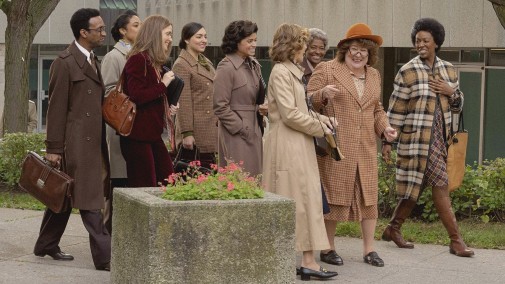
The voting period for the Emmy nominations is coming to an end. It's true that, now, a FYC may feel a bit late, but I can't let go of the opportunity to shine a light on one of the most impressive achievements in recent television. While I love to explore the marvels of acting, costume design will forever be my main passion when talking about the performing arts. The Emmys are particularly interesting when it comes to the honoring of costume excellence since, unlike the Oscars, they have categories separating Period, Contemporary and Fantasy designs, not to mention separate prizes for live specials. In theory, that makes it somewhat easier for great costuming to be honored but that's not always the case, especially when the clothes being considered are more subtle than showy. Sometimes, sheer flashiness can blind people, and subtler creations are left unrewarded.
Hopefully, such an unjust fate won't happen to the wondrous Mrs. America…

Bina Daigeler, the German costume designer of Mrs. America, should rightfully be a name known to cinephiles everywhere. In the past 25 years, she has worked with some of the best living filmmakers, like Pedro Almodóvar, Wim Wenders, Jim Jarmusch, and Steven Soderbergh. It was Daigeler who dressed Penélope Cruz in rich reds in Volver, who conjured the millennia-old styles of Only Lovers Left Alive's vampires, and invented the chameleonic looks for Cate Blanchett in Manifesto. 2020 was shaping up to be a breakout year for the designer who successfully jumped from auteur cinema to Disney blockbusters with Mulan. It's uncertain when we'll finally get to see that live-action remake, but, in the meantime, we can marvel at another of Daigeler's great feats of design.

Mrs. America, which tells the story of the fight for, and against, the Equal Rights Amendment during the 1970s, is a miniseries where the costumes play a role of great importance. On one hand, Daigeler's creations must reproduce the individual styles of historical figures whose clothes are well-documented. On the other, the reality is often devoid of narrative through lines, making it imperative that the designer figures out a way of telling the show's story while marrying drama and fact. There's also the matter of establishing the period, often using stylistic short-hand that may err on the side of archetypical simplifications, but is nonetheless necessary. In scenes where the pro-ERA faction face-off against their ideological opposites, for example, we must easily recognize the two groups in an instant.
The designer accomplishes such differentiation through a portraiture of fashion history that's painted with broad strokes. There is a homogeneous, hyper-feminine quality to the minions of Phyllis Schlafly, all pearl necklaces and shirtwaist dresses, soft cardigans, and sensible heels. In contrast, the pro-ERA women are riotous explosions of inchoate style with only the ideal of individualism holding them together. Some motifs may repeat, like braless silhouettes and bohemian details, but the projected image is one of barely controlled chaos. To look at their office spaces is to see inverse reflections, the demure rigidity of tradition versus the relative diversity of progress.

There's also the matter of color. One of the most striking aspects of Mrs. America is how it evokes the look of the 1970s without resembling a pastiche of retro aesthetics. The cinematography may be grainy in a way that recalls the cinematic classics of the era, but it doesn't deny its modernity. That's evident in the colors, which don't attempt to reproduce the tonalities of 1970s American film stock. Curiously enough, that recognizable palette, with an overwhelming presence of warm browns and pale blues, dusty pinks mixed with a hint of burnt orange and very little green, is transferred to the costumes rather than the cinematography. At times, it seems as if Daigeler took frames from Alice Doesn't Live Here Anymore or Network and used them as color swatches. Such chromatic games also help to give cohesion to a wardrobe full of the drastic stylistic contrasts mentioned before.

Still, the designer's work must also consider the case of each character and their place in the narrative, with special attention given to the more famous persons. Schlafly, for instance, is a bit of a walking contradiction. Her clothes exude a sense of conservative primness in their details and overall construction, but her outfits usually have more to do with office fashion than the style of American housewives. Another example is that of Shirley Chisholm, whose real-life ensembles are cannily adapted for the screen. A lot of the patterns and garments are near-exact reproductions, but their colors are often changed, either intensified or desaturated, the materials altered to make the disparity between her, her political adversaries, and inconsistent allies read more starkly than it might have in reality.

All this is a good reminder that, even when dressing history, a costume designer's job is never mere mimicry or fashion archeology. Mrs. America is a masterpiece of design as a sociopolitical signifier, period evocation through fashion and individual characterization by means of style. It should rightfully be nominated for the Emmy and, quite honestly, walk away with the gold. First up though, let's see if it gets nominated at all. While it might seem like a lock, you never know with the Television Academy. Remember when Mad Men's costumes, which never won this category, were snubbed for the series' last season? Let's keep our fingers crossed for Bina Daigeler.

You can watch all nine episodes of Mrs. America on Hulu.